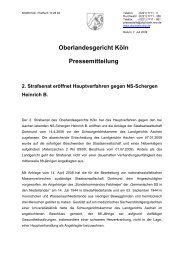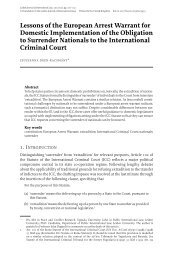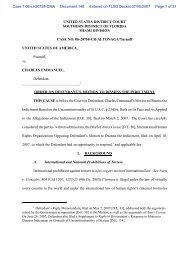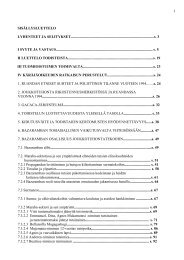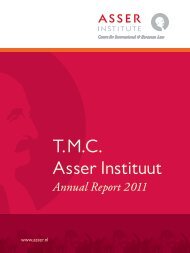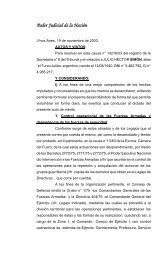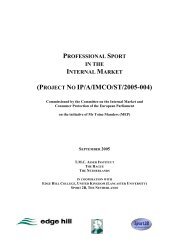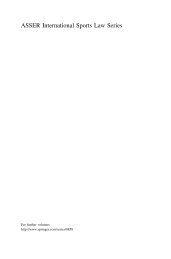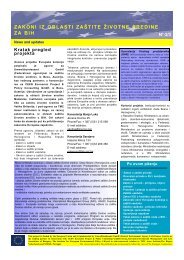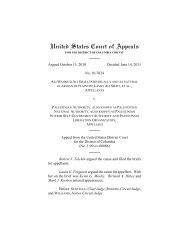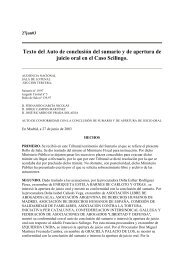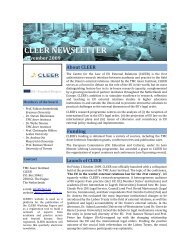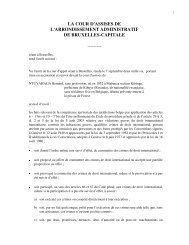Islj 2009 3-4 - TMC Asser Instituut
Islj 2009 3-4 - TMC Asser Instituut
Islj 2009 3-4 - TMC Asser Instituut
Create successful ePaper yourself
Turn your PDF publications into a flip-book with our unique Google optimized e-Paper software.
ing a player. In order to create an objective opinion about the role of<br />
sports agents, I will try to contact these actors as well. I was able to<br />
arrange a meeting with a manager of a club and one manager was able<br />
to respond by e-mail. I was not able to contact any player. So, an<br />
interesting part of the research is not included. It was also due to the<br />
lack of time and the busy period for players (the pre-season).<br />
The first interview is with an academic, with a high expertise on<br />
the field of sports agents. He is giving his academic view on the different<br />
topics in the market of sports agents. In this way, I can sketch<br />
the global picture of the market and from an independent view. The<br />
academic, who was willing to cooperate with the research, was Rob<br />
Siekmann.<br />
Besides the three main actors in the market and the academic, there<br />
are several other important actors present in the market. First of all,<br />
there are unions active. The ‘Vereniging Van Contractspelers’ (VVCS)<br />
is the union of the players. The most important role of the VVCS is<br />
that they are negotiating on behalf of all the Dutch professional players<br />
during the collectively bargaining process. The collectively bargaining<br />
process deals with the secondary working conditions. The collectively<br />
bargaining process will be discussed in chapter 2.2.5 and<br />
chapter 3.5.2. It would be interesting to know, what their opinion is<br />
about the sports agents and the interesting topics of the market.<br />
Furthermore, the ‘Federatie Betaald voetbal Organisaties’ (FBO) is<br />
present in the market. They are the union for the clubs and they are<br />
representing the clubs during the collectively bargaining process.<br />
Finally, the sports agents also have a union: ProAgent. ProAgent is<br />
also included in the research.<br />
The ‘Koninklijke Nederlandse Voetbal Bond’ (KNVB) is the regulator<br />
in the market of sports agents.<br />
They also monitor the market if some sports agents are not acting<br />
according the regulations and they can imposes fines or sanctions.<br />
They also issue the license and are responsible for the exam. They are<br />
an important actor on the market as a legislator. That is why, it would<br />
be interesting to include the KNVB in the research.<br />
Some interesting topics will be discussed during the interviews.<br />
The license is nowadays a hot topic in the market of sports agents and<br />
how it should be structured. Or if there needs to be a license at all,<br />
maybe is a free market a better option. On this moment, 103 sports<br />
agents received the license from the KNVB. Worldwide, there are<br />
thousands of sports agents. All sports agents with a license are permitted<br />
to be active in the Netherlands, also when the exam is done in<br />
Azerbaijan. So, this makes the market even more complex as it already<br />
is. It is not possible to include sports agents from all over the world.<br />
After several interviews, I will try to summarize the comments<br />
about the topics, like the license, transparency, monitoring function<br />
of KNVB and a possible new set of regulations. In this way, I can<br />
make some hypotheses about the market of sports agents. In the<br />
beginning of chapter 4, I will set some hypotheses and when the interviews<br />
are done, I can change the hypotheses. The research I will do is<br />
called explorative research, I am looking for hypotheses and I am not<br />
going to check them with quantitative research. It is clear that there<br />
is not a representative group, who I am going to interview. I was limited<br />
by time and the busy period for players and sports agents. The<br />
transfer period and the preseason are going on, when I am writing the<br />
thesis. This limits the results, but still there can be some interesting<br />
results. It is never been done before and in this research the view of<br />
the different unions are present, as well as the view of clubs and sports<br />
agents. So, I hope to formulate some interesting and clear hypotheses<br />
in the conclusions.<br />
2. The theoretical background of the market of sports agents<br />
In this chapter, the theoretical background will be discussed of the<br />
market of sports. Firstly, the sports agents will be discussed and what<br />
functions they fulfill. It will lead to a definition of sports agents,<br />
which will be used throughout the paper. After that, I will discuss the<br />
labor market of players. This discussion is needed, to make clear<br />
8 The article of R. Parrish: ‘Regulating<br />
Players’ Agents: A Global Perspective’ is<br />
published in the book of Siekmann et al.<br />
(2007), pp. 1-14.<br />
where the sports agents come in. Thirdly, some economic theories will<br />
be discussed, like the principal-agent problem and the bargaining at<br />
arm’s length.<br />
2.1. Sports agents<br />
An interesting study has been done by Sobel (1987) about the regulation<br />
of sports agents. He is not only giving ideas and insights about<br />
regulation, but he also describes the functions of a sports agent.<br />
This paragraph will explain what a sports agent is and what his<br />
functions are. In this way, I will avoid any discussion whether someone<br />
is a sports agent or not.<br />
2.1.1. Functions<br />
A sports agent is the representative of an athlete during negotiations<br />
and he has four main functions according to Sobel (1987), but these<br />
functions do not have to be done by a single agent. The definition of<br />
a sports agent is also given by Parrish in the book of Siekmann et al.<br />
(2007). 8 The definition is:<br />
‘An agent is a person authorized to act for another when dealing<br />
with third parties. In theory, a players’ agent is merely an intermediary<br />
ensuring the supply and demand for labor within sport is met.<br />
For a fee (commission), they assist players in finding clubs, or clubs<br />
in finding players’ (Siekmann et al., 2007, pp. 1-2)<br />
This is the definition, which will be used in this research. Now, the<br />
different functions will be explained from the article of Sobel (1987)<br />
The first function of the sports agent is the negotiating of an athlete’s<br />
contract. The service of contract negotiation is valuable for<br />
almost every athlete, because most athletes have little experience with<br />
negotiations and have no business background. This is the main reason,<br />
why there exists a market for sports agents. Sports agents have<br />
more knowledge over the salaries of other players than the athletes,<br />
and they have more knowledge of the details of collective bargaining<br />
agreements. For most athletes, this is a reason to hire a sports agent,<br />
to negotiate their contract. Also athletes with a business background<br />
will hire a sports agent, because the bargaining process during the<br />
negotiations can influence the performance of the athlete. Sports<br />
agents have an insulating function. The insulating function of sports<br />
agents during the bargaining process is when a player has to play for<br />
the club after successful negotiations. When there were critics from<br />
the club (in order to bargain a lower salary), it could affect the performance<br />
of the athlete. Shropshire and Davis (2008) also thinks that<br />
the insulating function of a sports agent is very important. It will<br />
return in chapter 2.4.4. A good example of the insulating function of<br />
a sports agent is shown in the movie Jerry Maguire. The athlete in<br />
the movie wants a renewal of his contract, but the sports agent is<br />
hearing all the critics on the player. It depends on the sports agent,<br />
what the player is hearing. The movie is a good movie about the<br />
sports agent and the relation between the sports agent and player is<br />
shown clearly.<br />
The second function of a sports agent is obtaining, reviewing and<br />
negotiating new contracts. This is also in the commercial sector to get<br />
sponsor contracts for the athlete. When the contract of a player<br />
expires, the sports agent is responsible for the negotiations during the<br />
renewal of a contract. The first function, described above, is getting<br />
the athlete at a club, but after this the relation continues. The sports<br />
agent can obtain other contracts from third parties or a renewal of the<br />
current contract with the club. A good example of an endorsement is<br />
the deal between Nike and Roger Federer. Roger Federer is one of best<br />
tennis players of the world and is dominating it for a few years now.<br />
He signed a tenyear deal with Nike, for more than ten million dollar<br />
a year. This is part of the second function of sports agents, to arrange<br />
sponsor contracts for their players. In this research, the focus of function<br />
two will be on reviewing and the negotiating of the current contract<br />
with the clubs. The sponsor’s contracts will be excluded. It is<br />
important to specify the research. If the sponsor’s contracts will be<br />
included, it will become more difficult to sketch the whole market of<br />
sports agents.<br />
The third function according to Sobel (1987) is investment advice<br />
and income management. This is different from the first two func-<br />
74 <strong>2009</strong>/3-4<br />
A RT I C L E S



